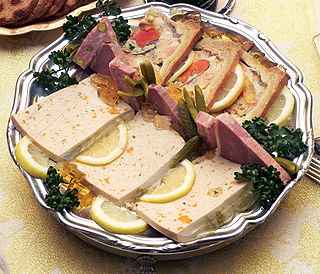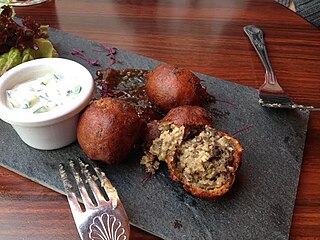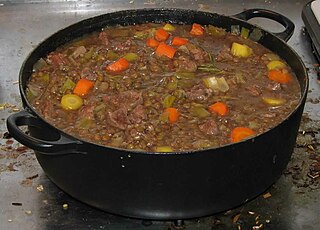EBLEX ("English Beef and Lamb Executive"), now called AHDB Beef and Lamb is a division of the Agriculture and Horticulture Development Board (AHDB) and delivers services to beef and lamb levy payers in England. It exists to enhance the competitiveness and sustainability of the English beef and lamb sector. It was renamed Beef and Lamb in June 2015. Its functions and aims remain unchanged.
AHDB Beef and Lamb have the following aims:
It is funded through a statutory levy paid to the AHDB on all beef and sheep animals slaughtered in, or live animals exported from, England.

Haggis is a savoury pudding containing sheep's pluck, minced with onion, oatmeal, suet, spices, and salt, mixed with stock, and cooked while traditionally encased in the animal's stomach though now an artificial casing is often used instead. According to the 2001 English edition of the Larousse Gastronomique: "Although its description is not immediately appealing, haggis has an excellent nutty texture and delicious savoury flavour".

Tripe is a type of edible lining from the stomachs of various farm animals. Most tripe is from cattle, pigs and sheep.

Lamb, hogget, and mutton, generically sheep meat, are the meat of domestic sheep, Ovis aries. A sheep in its first year is a lamb and its meat is also lamb. The meat from sheep in their second year is hogget. Older sheep meat is mutton. Generally, "hogget" and "sheep meat" are not used by consumers outside Norway, New Zealand, South Africa, Scotland, and Australia. Hogget has become more common in England, particularly in the North often in association with rare breed and organic farming.

Offal, also called variety meats, pluck or organ meats, is the internal organs of a butchered animal. The word does not refer to a particular list of edible organs, and these lists of organs vary with culture and region, but usually exclude skeletal muscle. Offal may also refer to the by-products of milled grains, such as corn or wheat.

Sausage casing, also known as sausage skin or simply casing, is the material that encloses the filling of a sausage. Natural casings are made from animal intestines or skin; artificial casings, introduced in the early 20th century, are made of collagen and cellulose. The material is then shaped via a continuous extrusion process – producing a single sausage casing of indefinite length – which is then cut into desired lengths, usually while the extrusion process continues.

Steak and kidney pie is a popular British dish. It is a savoury pie filled principally with a mixture of diced beef, diced kidney and onion. Its contents are generally similar to those of steak and kidney puddings.

Irish stew is a stew native to Ireland that is traditionally made with root vegetables and lamb or mutton, but also commonly with beef. As in all traditional folk dishes, the exact recipe is not consistent from time to time, or place to place. Basic ingredients include lamb, or mutton, as well as potatoes, onions, and parsley. It may sometimes also include carrots. Irish stew is also made with kid.
Irish stew is a celebrated Irish dish, yet its composition is a matter of dispute. Purists maintain that the only acceptable and traditional ingredients are neck mutton chops or kid, potatoes, onions, and water. Others would add such items as carrots, turnips and pearl barley; but the purists maintain that they spoil the true flavour of the dish. The ingredients are boiled and simmered slowly for up to two hours. Salt can be added before or after the cooking. Mutton was the dominant ingredient because the economic importance of sheep lay in their wool and milk produce and this ensured that only old or economically non-viable animals ended up in the cooking pot, where they needed hours of slow cooking. Irish stew is the product of a culinary tradition that relied almost exclusively on cooking over an open fire. It seems that Irish stew was recognised as early as about 1800.

Steak and kidney pudding is a traditional British main course in which beef steak and beef, veal, pork or lamb kidney are enclosed in suet pastry and slow-steamed on a stovetop.
The Meat and Livestock Commission, (MLC), was set up by the UK Government under the Agriculture Act 1967 with Government money with the remit to promote the sale of red meat. The MLC was previously an independent non-departmental public body, but from 1 April 2008 it was superseded by the Agriculture and Horticulture Development Board.

Sheep or domestic sheep are domesticated, ruminant mammals typically kept as livestock. Although the term sheep can apply to other species in the genus Ovis, in everyday usage it almost always refers to domesticated sheep. Like all ruminants, sheep are members of the order Artiodactyla, the even-toed ungulates. Numbering a little over one billion, domestic sheep are also the most numerous species of sheep. An adult female is referred to as a ewe, an intact male as a ram, occasionally a tup, a castrated male as a wether, and a young sheep as a lamb.
The Agriculture and Horticulture Development Board (AHDB) is a levy board funded by farmers and growers and some other parts of the supply chain. It aims to enhance farm business efficiency and competitiveness in the areas of: pig, beef and lamb production in England; milk, potatoes and horticulture in Great Britain; and cereals and oilseeds in the United Kingdom. It undertakes research and development and farm-level knowledge transfer activity, provides essential market information to improve supply chain transparency and undertakes marketing promotion activities to help stimulate demand and to develop export markets. These are activities which most individual farm businesses could not afford to do themselves.

Meat & Livestock Australia (M&LA) is an independent company which regulates standards for meat and livestock management in Australian and international markets. Headquartered in North Sydney, Australia; M&LA works closely with the Australian government, and the meat and livestock industries. M&LA has numerous roles across the financial, public and research sectors. The M&LA corporate group conducts research and offers marketing services to meat producers, government bodies and market analysts alike. Forums and events are also run by M&LA aim to provide producers with the opportunity to engage with other participants in the supply chain.

A steak is a thick cut of meat generally sliced across the muscle fibers, sometimes including a bone. It is normally grilled or fried. Steak can be diced, cooked in sauce, such as in steak and kidney pie, or minced and formed into patties, such as hamburgers.
Quality Meat Scotland (QMS) is an executive non-departmental public body of the Scottish Government. It promotes the red meat sector and markets the Protected Geographical Indication Scotch Beef and Scotch Lamb brands.
The New Zealand Meat Board is a statutory body which provides quota management on behalf of the Crown for meat exports to the United States, European Union and United Kingdom. To protect their own livestock industry these countries give limited access to New Zealand meat exports.

Haggis pakora is a Scottish snack food that combines traditional Scottish haggis ingredients with the spices, batter and preparation method of Indian and Pakistani pakoras. It has become a popular food in Indian and Pakistani restaurants in Scotland, and is also available in prepared form in supermarkets.

A stew is a combination of solid food ingredients that have been cooked in liquid and served in the resultant gravy. Ingredients can include any combination of vegetables and may include meat, especially tougher meats suitable for slow-cooking, such as beef, pork, venison, rabbit, lamb, poultry, sausages, and seafood. While water can be used as the stew-cooking liquid, stock is also common. A small amount of red wine or other alcohol is sometimes added for flavour. Seasoning and flavourings may also be added. Stews are typically cooked at a relatively low temperature, allowing flavours to mingle.
The National Animal Disease Information Service (NADIS) is a British veterinary organisation that limits the spread of animal diseases; it is partly government-funded.